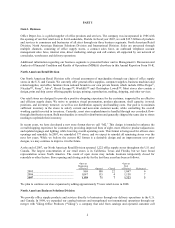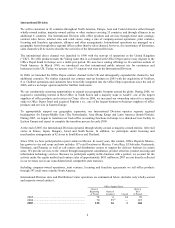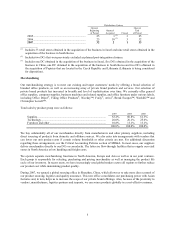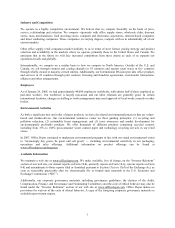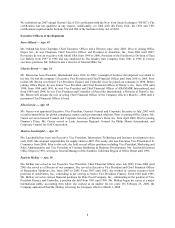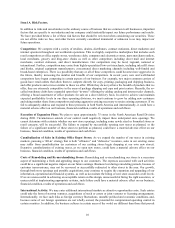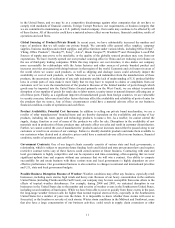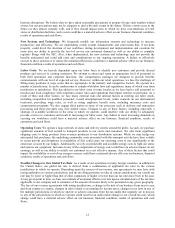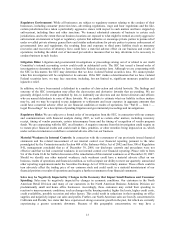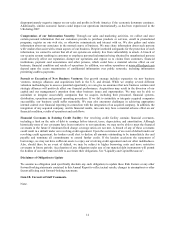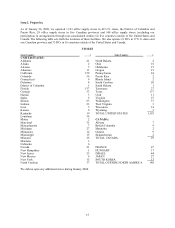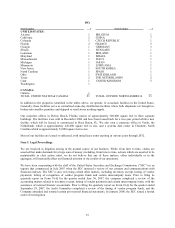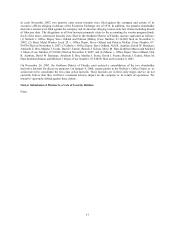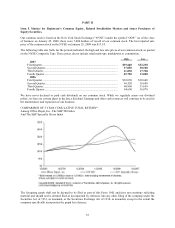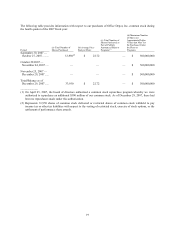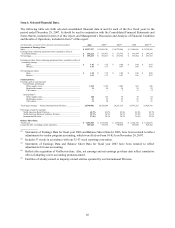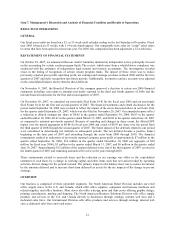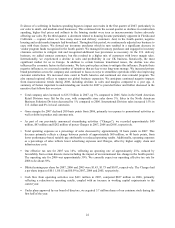Office Depot 2007 Annual Report Download - page 14
Download and view the complete annual report
Please find page 14 of the 2007 Office Depot annual report below. You can navigate through the pages in the report by either clicking on the pages listed below, or by using the keyword search tool below to find specific information within the annual report.12
business disruptions. We believe that we have taken reasonable precautions to prepare for any such weather-related
events, but our precautions may not be adequate to deal with such events in the future. If these events occur in the
future (as they almost certainly will), and if they should impact areas in which we have concentrations of retail
stores or distribution facilities, such events could have a material adverse effect on our business, financial condition,
results of operations and cash flows.
New Systems and Technology: We frequently modify our information systems and technology to increase
productivity and efficiency. We are undertaking certain system enhancements and conversions that, if not done
properly, could divert the attention of our workforce during development and implementation and constrain for
some time our ability to provide the level of service our customers demand as well as our ability to complete
requisite filings with the SEC. Also, when implemented, the new systems and technology may not provide the
benefits anticipated and could add costs and complications to our ongoing operations. A failure to effectively
convert to these systems or to realize the intended efficiencies could have a material adverse effect on our business,
financial condition, results of operations and cash flows.
Labor Costs: We are heavily dependent upon our labor force to identify new customers and provide desired
products and services to existing customers. We attempt to attract and retain an appropriate level of personnel in
both field operations and corporate functions. Our compensation packages are designed to provide benefits
commensurate with our level of expected service. However, within our retail operations, we face the challenge of
filling many positions at wage scales that are appropriate to the industry and competitive factors. We operate in a
number of jurisdictions. It can be cumbersome to comply with labor laws and regulations, many of which vary from
jurisdiction to jurisdiction. This has added to our labor costs in some locales as we have had to add personnel to
monitor and track compliance with sometimes arcane rules and regulations that impact retailers in particular. As a
result of these and other factors, we face many external risks and internal factors in meeting our labor needs,
including competition for qualified personnel, overall unemployment levels, works councils (in our international
locations), prevailing wage rates, as well as rising employee benefit costs, including insurance costs and
compensation programs. We also engage third parties in some of our processes such as delivery and transaction
processing and these providers may face similar issues. Changes in any of these factors, including especially a
shortage of available workforce in the areas in which we operate, could interfere with our ability to adequately
provide services to customers and result in increasing our labor costs. Any failure to meet increasing demands on
securing our workforce could have a material adverse effect on our business, financial condition, results of
operations and cash flows.
Operating Costs: We operate a large network of stores and delivery centers around the globe. As such, we purchase
significant amounts of fuel needed to transport products to our stores and customers. We also incur significant
shipping costs to bring products from overseas producers to our distribution systems. While we may hedge our
anticipated fuel purchases, the underlying commodity costs associated with this transport activity have been volatile
in recent periods and disruptions in availability of fuel could cause our operating costs to rise significantly to the
extent not covered by our hedges. Additionally, we rely on predictable and available energy costs to light our stores
and operate our equipment. Increases in any of the components of energy costs could have an adverse impact on our
earnings, as well as our ability to satisfy our customers in a cost effective manner. Any of these factors that could
impact the availability or cost of our energy resources could have a material adverse effect on our business, financial
condition, results of operations and cash flows.
Possible Changes to Our Global Tax Rate: As a result of our operations in many foreign countries, in addition to
the United States, our global tax rate is derived from a combination of applicable tax rates in the various
jurisdictions in which we operate. Depending upon the sources of our income, any agreements we may have with
taxing authorities in various jurisdictions, and the tax filing positions we take in various jurisdictions, our overall tax
rate may be lower or higher than that of other companies or higher or lower than our tax rates have been in the past.
At any given point in time, we base our estimate of an annual effective tax rate upon a calculated mix of the tax rates
applicable to our company and to estimates of the amount of income likely to be generated in any given geography.
The loss of one or more agreements with taxing jurisdictions, a change in the mix of our business from year to year
and from country to country, changes in rules related to accounting for income taxes, changes in tax laws in any of
the multiple jurisdictions in which we operate or adverse outcomes from the tax audits that regularly are in process
in any of the jurisdictions in which we operate could result in an unfavorable change in our overall tax rate, which
change could have a material adverse effect on our business, financial condition, results of operations and cash
flows.


